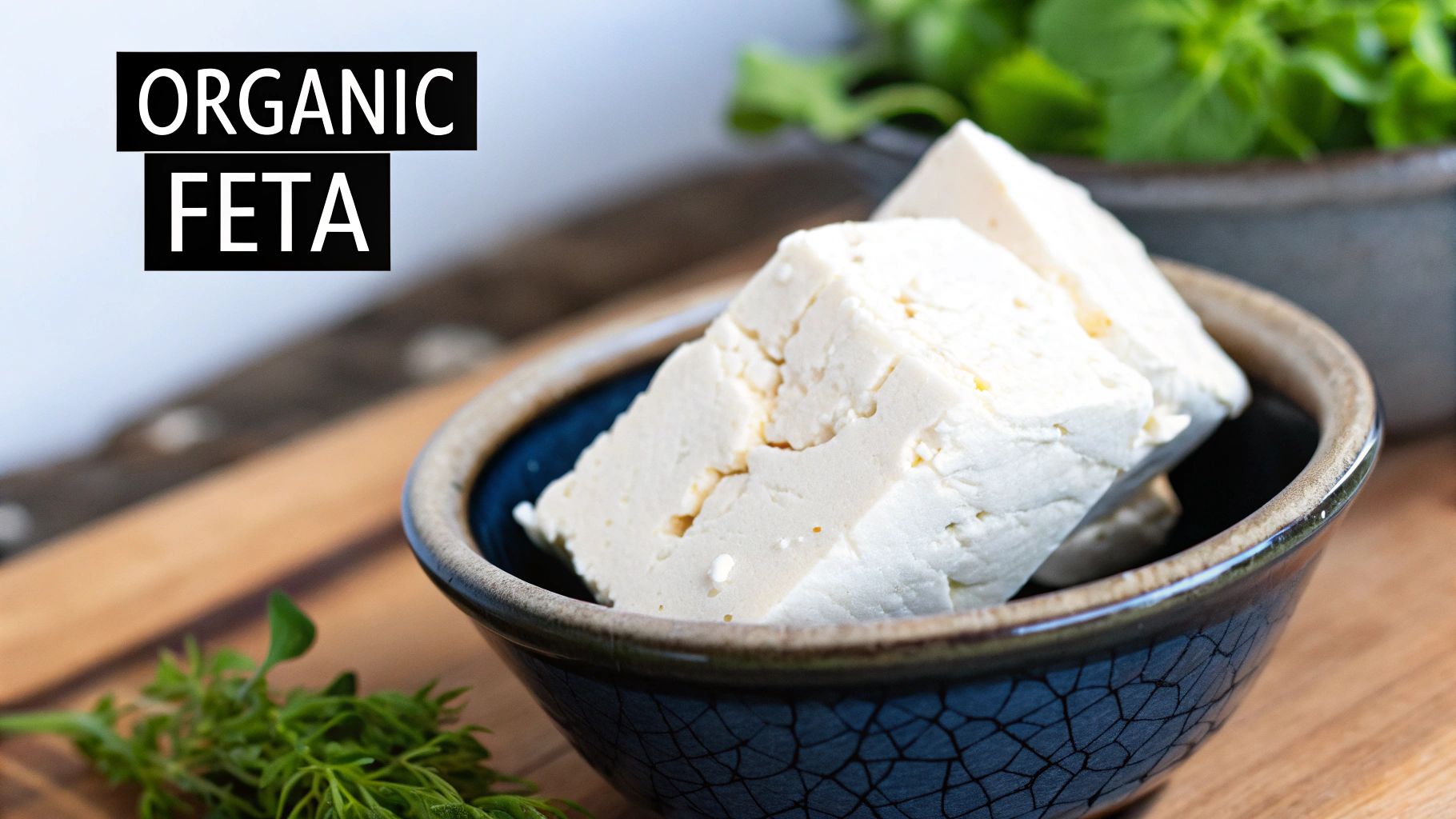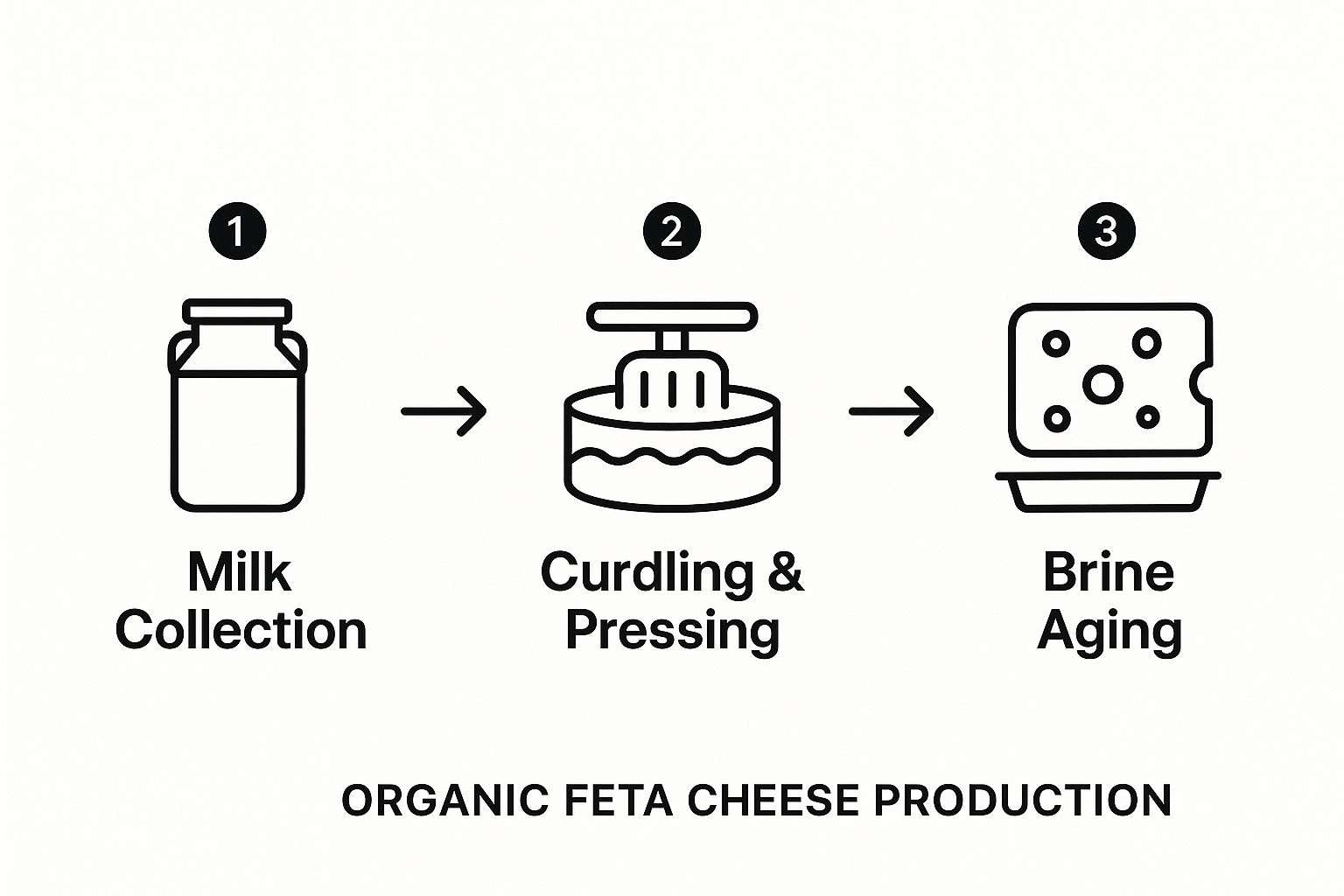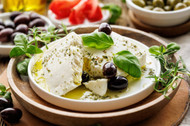A Guide to Organic Feta Cheese
Posted by Garden & Table on 21st Jul 2025
A Guide to Organic Feta Cheese
Picture a small, well-tended garden bursting with fragrant herbs, then contrast that with a massive, industrial farm. That's the heart of the difference with organic feta cheese. It’s more than just a label; it represents a deep commitment to a more natural, higher standard of quality. The result is a superior flavor and texture that can only come from a healthier, more sustainable way of doing things.
What Makes Organic Feta Cheese Different?

To really get what makes organic feta special, you have to understand the philosophy behind the organic seal. It’s a seal of approval backed by a strict set of rules for farming and production, standards that go well beyond what’s required for conventional cheese. Think of it as a quality guarantee that starts long before the cheesemaking even begins.
This dedication to quality is rooted in how the animals are raised. On an organic farm, the sheep and goats must have access to open pasture where they can graze naturally. It's a holistic approach that not only leads to a better life for the animals but also produces richer, more complex milk.
The Foundation: Animal Welfare and Diet
The core idea of organic dairy farming is simple: treat the animals with respect. This means creating an environment that lets them behave as they would in nature.
Even more importantly, what they eat is carefully controlled. These animals graze on pastures completely free from synthetic pesticides and fertilizers. Any extra feed they get must be 100% organic and non-GMO. This is a critical point that directly shapes the quality of the cheese you put on your table.
When you choose organic feta, you're not just buying cheese. You're supporting a system that puts the health of the animals and the land first. It’s an agricultural choice that translates directly into a culinary one, delivering a cleaner, more authentic flavor.
Understanding PDO and Organic Certifications
When you're shopping for the best feta, you’ll often see two key designations that, together, signify the highest standard of quality: Protected Designation of Origin (PDO) and organic certification. It helps to think of them as two layers of assurance that complement each other perfectly.
- Protected Designation of Origin (PDO): This is all about tradition. As a legal framework, it ensures true feta is made only in specific regions of Greece with at least 70% sheep's milk (the rest can be goat's milk). PDO guarantees the cheese follows time-honored methods.
- Organic Certification: This adds a crucial layer of purity on top of the PDO rules. It certifies that the milk comes from animals raised under strict organic standards. That means no routine antibiotics, no synthetic growth hormones, and absolutely no GMO feed.
When you purchase one of our Garden & Table organic feta products, you're getting a cheese that honors both of these pillars—tradition and sustainability. This dual certification is the gold standard, promising an experience that is both authentic and exceptionally pure. It's the perfect way to elevate simple dishes, whether you're crumbling it over roasted carrots with a drizzle of our organic honey or adding that salty, briny kick to a fresh summer salad made with our garden-fresh produce.
The Journey From Pasture to Your Plate
Every block of authentic organic feta cheese has a story, and it starts long before it ever lands in your kitchen. This story begins in the rolling green pastures where healthy sheep and goats roam free, grazing on the land. Unlike conventional farming, this entire journey is guided by strict organic principles, ensuring the final cheese is as pure and natural as the land it came from.
The secret to incredible cheese is, without a doubt, incredible milk. For our organic feta, that means the animals' diet is everything. They graze on land that’s completely free of synthetic pesticides and fertilizers. This commitment ensures no unwanted chemical residues ever find their way into the milk, preserving its natural integrity right from the start.
This adherence to organic standards is a line we don't cross. It means a strict ban on routine antibiotics and artificial growth hormones. Instead, the flock's health is maintained through natural methods, a clean environment, and a nutrient-rich diet. This holistic approach doesn't just support superior animal welfare; it directly contributes to the rich, complex flavor that defines a truly high-quality organic feta.
The Art of Organic Cheesemaking
Once the pure, organic milk is collected, the traditional craft of cheesemaking can begin. Each stage is carefully managed to maintain its organic integrity, transforming that pristine milk into the briny, crumbly cheese we all love, all while honoring time-tested methods.
This simple visual breaks down the three core stages of our organic feta production.

As you can see, the journey from milk to cheese is a disciplined process. Each phase builds on the last to develop the feta's signature character.
First, the milk is gently warmed before we introduce a starter culture and organic-compliant rennet. This causes the milk to coagulate, separating the solid curds from the liquid whey. It's a delicate dance of temperature and timing, absolutely crucial for getting the perfect texture. The resulting curds are soft and fragile, holding all the rich potential of the final cheese.
Next, we carefully cut the curds and transfer them into molds. This allows the remaining whey to drain away naturally, without any harsh mechanical pressing. The fresh blocks of cheese are then cut to size and salted—a key step that draws out more moisture, firms up the texture, and kicks off the preservation process.
The Magic of the Brine
The final, most transformative stage is aging. The blocks of feta are submerged in a salt brine, where they will mature for several weeks, or even months. This is where the real magic happens.
The brine isn’t just a preservative; it’s an essential ingredient. During this time, the cheese develops its characteristic tangy flavor, salty bite, and firm yet creamy texture. Of course, the quality of the water and salt used in the brine must also meet organic standards.
This patient aging process is what sets authentic feta apart. It simply can’t be rushed. The slow maturation allows the flavors to deepen and grow more complex, resulting in a cheese that beautifully expresses the quality of the organic milk it was made from.
This dedication to authentic, sustainable methods is catching on. The global market for feta cheese has seen major growth, powered by a rising interest in Mediterranean cuisine and shoppers seeking healthier, specialty foods. Organic feta is perfectly positioned to meet this demand, appealing directly to those who value natural, transparently produced products. This reflects a broader shift in food culture, where quality and origin matter more than ever.
From the sun-drenched organic pastures to the meticulous aging in brine, every block of our organic feta is a testament to this process. It’s a food crafted with intention, perfect for elevating a simple weeknight meal, like these Roasted Maple Glazed Carrots with Feta, or starring on a beautiful charcuterie board alongside our artisan crackers and organic olives. It's a journey of patience, tradition, and a deep respect for nature.
Tasting the Superior Flavor and Texture

Ultimately, the real test of any food is how it tastes, and this is where organic feta cheese truly shines. If your only experience is with conventional feta, you might think of it as one-dimensional—just a salty, sometimes chalky cheese. But authentic organic feta is a completely different world, offering a complex and satisfying experience from the very first bite.
Forget about that aggressive, overpowering saltiness. With a quality organic feta, the brine is a partner to the cheese's natural flavor, not a bully. It delivers a clean, bright tang that wakes up your palate, which then gives way to subtle, earthy notes that hint at its pure origins. It’s a beautifully balanced act.
The Creamy Consistency and Grassy Notes
The texture is one of the first things you'll notice. A real organic feta is firm enough to crumble perfectly over a salad, yet it has a remarkable creaminess. It’s a far cry from the dry, brittle texture of many mass-produced versions and has an almost melt-in-your-mouth quality.
This rich texture is no happy accident. It’s a direct result of using high-quality organic milk from sheep and goats that spend their days grazing on diverse pastures. They munch on a natural buffet of grasses, wildflowers, and herbs, and that varied, nutrient-dense diet creates milk with a higher fat content and more complex flavor. The end product is a richer, creamier cheese with delicate grassy notes you just don't get from its conventional counterparts.
The flavor of organic feta is a direct reflection of its environment. Those subtle, fresh notes are the taste of the healthy, biodiverse pastures where the animals graze freely. It’s the flavor of nature, not just a factory.
The Science Behind the Superior Taste
This isn't just a matter of opinion; there's real science behind why organic feta tastes better. The milk from animals raised on pasture has a measurably different chemical makeup. Research has shown that milk from grass-fed animals is richer in beneficial fatty acids, including higher levels of Omega-3s and Conjugated Linoleic Acid (CLA).
These compounds aren't just good for you—they are fundamental to the cheese's aroma and flavor. This unique blend of fatty acids gives organic feta its distinctive character and a depth that milk from factory-farmed animals simply can't produce.
In short, a healthier animal living on a natural diet creates a more flavorful and nutritionally dense cheese. It's a simple, traceable line from the pasture right to your plate.
Organic vs Conventional Feta A Quick Comparison
To see the differences in a snapshot, it helps to compare how organic and conventional feta are made and how that affects the cheese you bring home. This table breaks down why choosing organic is a step up in quality.
| Attribute | Organic Feta Cheese | Conventional Feta Cheese |
|---|---|---|
| Animal Diet | Grazing on organic pastures, supplemented with 100% organic, non-GMO feed. | Often confined and fed a standardized diet of conventional, GMO-based grains. |
| Flavor Profile | Complex, with balanced saltiness, a creamy tang, and subtle grassy notes. | Can be one-dimensionally salty, sometimes with a sharp, acidic aftertaste. |
| Texture | Firm yet creamy and smooth, crumbles easily without being dry. | Frequently dry, brittle, and chalky in consistency. |
| Milk Quality | Higher in beneficial fatty acids like Omega-3s and CLA from pasture-grazing. | Fatty acid profile reflects a grain-based diet, lacking pasture-derived nutrients. |
These differences are precisely why our Garden & Table organic feta can elevate any meal from simple to special. It’s more than just an ingredient; it becomes a feature of the dish. Try it with roasted carrots from our produce selection drizzled with maple syrup—the cheese’s balanced saltiness and creamy texture provide the perfect savory counterpoint, creating a truly memorable side.
The Health and Environmental Benefits
When you choose a product like our Garden & Table organic feta, you're making a decision that goes well beyond your dinner plate. It's a choice that supports your own health while also making a real, positive impact on the planet. The benefits are tangible, from a richer nutritional profile in every bite to farming methods that protect the environment for years to come.
Opting for organic feta is essentially an investment in cleaner food. That organic seal is your guarantee that the cheese comes from milk free of synthetic pesticides, herbicides, artificial hormones, and the routine use of antibiotics. It means you're getting feta as nature intended, without any unwanted chemical baggage.
A Richer Nutritional Profile
How an animal is raised directly shapes the quality of its milk, and this is where organic farming truly shines. When sheep and goats graze on diverse, natural pastures, they produce milk that is often a world apart from their conventionally-raised counterparts.
You can see this difference most clearly in the milk's fatty acid composition. Milk from pasture-raised animals is typically higher in beneficial Omega-3 fatty acids, which are vital for heart and brain health. It's also a better source of Conjugated Linoleic Acid (CLA), another healthy fat that has been linked to a wide range of wellness benefits.
Choosing organic feta isn't just about incredible flavor; it's about getting a more nutrient-dense product. The healthier, more natural diet of the animals translates directly into a healthier cheese for you and your family.
This focus on health and transparency is catching on. The growing demand for organic feta is part of a much larger shift toward sustainable, whole foods. As Mediterranean cuisine—famous for its health perks—gains popularity around the globe, so does the desire for its star ingredients, like authentic, high-quality feta. Market data consistently shows that the organic food sector is outpacing conventional markets, a trend powered by this very change in what consumers value. You can explore more about these innovations and market trends in the organic feta industry to see how things are evolving.
An Investment in a Healthier Planet
The beautiful thing about organic farming is that its benefits ripple outward, creating a healthier environment. It’s a system built on working with nature, not fighting against it.
Organic standards forbid the use of synthetic chemical fertilizers and pesticides. This one rule has a cascade of positive effects on the environment:
- Better Soil Health: Instead of dousing fields with chemicals, organic farmers build rich, living soil through composting, cover crops, and crop rotation. This creates a foundation that's teeming with nutrients and holds water more effectively, making the land more resilient to drought.
- Cleaner Waterways: With no chemical runoff, nearby rivers, lakes, and groundwater are kept safe from contamination. This protects aquatic life and ensures cleaner drinking water for surrounding communities.
- Thriving Biodiversity: Organic farms become bustling ecosystems. The lack of harsh pesticides allows insects, birds, and other wildlife to flourish, creating the kind of balanced environment that nature intended.
By choosing our organic feta, you're helping to build a more sustainable food system. Every purchase supports farmers committed to protecting our natural resources. It’s a simple, delicious way to make a responsible choice, whether you're crumbling it over a salad made with our fresh produce or baking it into a warm, savory pie with our organic flour and eggs.
How to Use Organic Feta in Your Kitchen

Alright, you've learned what sets a truly high-quality organic feta apart. Now for the fun part: actually using it in your own kitchen. This cheese is so much more than a simple salad topping. Think of it as a secret weapon that can transform meals from breakfast all the way to dinner, thanks to its one-of-a-kind creamy texture and salty, tangy flavor.
The real magic happens when you know how to let it shine. Whether you crumble it cold for a fresh pop, bake it until it’s warm and soft, or whip it into a decadent dip, our Garden & Table organic feta cheese is ready to elevate your favorite recipes.
Crumbled Cold for Freshness and Bite
The classic way to enjoy feta is often the best. When crumbled straight from the brine, it delivers a bright, savory punch that can liven up an incredible range of dishes. This method keeps its texture firm yet creamy and lets that signature salty tang take center stage.
Of course, a fantastic chopped salad is a great starting point. The crisp, vibrant textures of our fresh organic vegetables provide the perfect backdrop for the bold flavor of organic feta. Its creaminess beautifully balances the sharp bite of red onion and the crunch of romaine, turning a simple salad into a genuinely satisfying meal.
Don't just stop at a Greek salad. The true genius of crumbled feta shines when you pair it with unexpected partners. Its salty kick creates a beautiful contrast with sweet fruits, earthy vegetables, and hearty grains.
Try these simple yet unforgettable combinations using ingredients from Garden & Table:
- Watermelon and Mint: A timeless summer pairing where the feta’s saltiness makes the watermelon taste impossibly sweeter.
- Roasted Beets and Walnuts: The cheese cuts right through the earthy sweetness of the beets, and the walnuts add a perfect, crunchy texture.
- Quinoa and Chickpeas: Tossing feta into a grain bowl adds a burst of flavor and a creamy element that ties everything together.
Baked and Roasted for Warm, Savory Depth
While organic feta cheese won't melt into a stringy puddle like mozzarella, something wonderful happens when you heat it. It becomes incredibly soft and creamy, and its flavor deepens, bringing out nuttier notes while mellowing its saltiness. This makes it an amazing centerpiece for warm dishes.
One of the easiest and most popular ways to experience this is the famous "baked feta pasta." Just put a block of our organic feta in a baking dish, scatter our cherry tomatoes around it, add a generous drizzle of our organic olive oil, and roast. The tomatoes will burst and the cheese will soften into a rich, instant sauce you can mash and toss with our artisan pasta.
Baked feta is also fantastic in savory pastries. Imagine flaky spanakopita (spinach pie) or small, handheld turnovers filled with feta and herbs from our pantry section. The cheese becomes warm and yielding, offering a tangy counterpoint to the rich pastry. For a show-stopping side dish, try crumbling it over roasted maple-glazed carrots, where its saltiness perfectly balances the sweet glaze.
Whipped and Blended into Creamy Dips
Turning a block of organic feta into a smooth, luxurious dip is one of the most rewarding and impressive ways to use it. With just a food processor, you can unlock its creamiest potential and create a stunning appetizer with very little effort.
To make a basic whipped feta, just blend the cheese with a splash of our organic olive oil and a bit of plain yogurt or cream cheese until it reaches a silky-smooth consistency. That’s your blank canvas.
From there, the possibilities are endless:
- Herbs and Lemon: Fold in fresh dill and parsley from our produce section and a squeeze of lemon juice for a bright, zesty dip that’s perfect with fresh vegetables or warm pita bread.
- Roasted Garlic and Honey: Blend in a few cloves of sweet roasted garlic and finish with a drizzle of our organic honey for a sophisticated savory-sweet spread.
- Sun-Dried Tomatoes: Mix in some of our rich, flavorful sun-dried tomatoes to give the dip a bold Mediterranean character.
Serve these dips on one of our curated charcuterie boards with an assortment of our crackers and crudités for a sophisticated start to any gathering. Stored in an airtight container, your dip will stay fresh for several days, ready for your next craving.
Answering Your Top Questions About Organic Feta
As people get more curious about organic feta, some common questions tend to pop up. Getting to the bottom of these helps you truly appreciate what makes this cheese so special and how to get the most out of every crumbly bite. Here are the answers to what we hear most often from our customers.
Is Organic Feta Always Made From Sheep's Milk?
For a cheese to be called authentic organic feta with a Protected Designation of Origin (PDO) status, the rules are very specific. It has to be made with at least 70% sheep's milk. The other 30% can be goat's milk, and all of it must come from designated regions in Greece under strict organic farming practices.
You'll definitely find other "feta-style" cheeses out there, but if you want the real deal—the kind we stand by—it has to follow these traditional milk recipes. That's where the genuine creamy texture and tangy flavor come from.
Does Organic Feta Taste Saltier Than Regular Feta?
Actually, it's usually the other way around. A really well-made organic feta has a much more complex and balanced flavor. The salt is there, but its job is to bring out the rich, tangy notes of the pure organic milk, not to steal the show. Think of it as a beautiful harmony of flavors instead of just a blast of salt.
Pro Tip: If your feta is ever a bit too briny for a particular dish, there's a simple trick. Just give the block a quick rinse under some cool running water before you use it. This washes off some of the surface brine without touching the wonderful flavor locked inside the cheese.
How Do I Know My Feta Is Genuinely Organic?
This one is easy—just check the packaging for official certification seals. These logos are your guarantee that the cheese meets strict government standards, from the farm right through to the package you're holding.
- In the United States, look for the ‘USDA Organic’ seal.
- In the European Union, the green ‘EU Organic’ leaf logo is the standard.
When you spot these seals on our products, you can rest easy knowing you’re buying truly organic feta.
Is Organic Feta Good For Cooked Dishes?
Absolutely! It’s a star in the kitchen. Organic feta doesn't really melt like mozzarella; instead, it softens beautifully when heated, adding a creamy, savory depth to hot meals.
It's fantastic baked into savory pies like spanakopita, roasted with our cherry tomatoes and organic olive oil to create a viral-worthy pasta sauce, or crumbled into hearty quiches and frittatas using our organic eggs. Its versatility is one of its best features.
Ready to taste the difference for yourself? Explore the full range of premium cheeses and other gourmet foods at Garden & Table.
Discover our selection of artisanal organic feta cheese and more at gardenandtable.net

